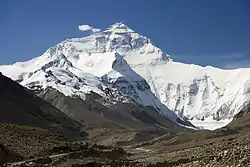Himavat
Himavat (Sanskrit: हिमवत्, lit. frosty) or Himavant (Sanskrit: हिमवन्त, lit. icy) or Himavān (Sanskrit: हिमवान्, lit. snowy) or Himaraja (Sanskrit: हिमराज, lit. king of snow) or Parvateshwara (Sanskrit: पर्वतेश्वर, lit. lord of mountains) is the personification of the Himalayan mountains, which are also known as the Himavat Mountains. He was the ruler of the Himalaya Kingdom of Ancient India, which finds mention in the epic Mahabharata.
| Himavan | |
|---|---|
King of Mountains and Snow | |
 Himalayas | |
| Devanagari | हिमवत् |
| Affiliation | Rana |
| Abode | Himalayas |
| Personal information | |
| Parents |
|
| Siblings | Jambavan, Narada etc |
| Consort | Menavati |
| Children | Ganga Parvati Mainak |
Himavat fathered Ganga the river goddess, as well as Ragini[1] and Parvati, the wife of Shiva. His wife and queen consort is Vedic Menavati, the daughter of Mount Meru.[2]
The sacred text of Devi Gita, which is found in the last nine chapters (31-40) of the seventh skandha of Devi-Bhagavata Purana, is a dialogue between Parvati and her father Himavat. It deals with the universal form of the Devi, meditations on the major texts of Upanishads, ashtanga-yoga, the yogas of jnana, karma and bhakti, locations of the temples dedicated to the Devi and the rituals pertaining to her worship.
His story also finds mention in Brahmanda Purana and Kena Upanishad.[3]
References
- Jones, Constance; Ryan, James D. (2006-01-01). Encyclopedia of Hinduism. Infobase Publishing. ISBN 9780816075645.
- Wilkins, p. 287
- Kena Upanisad, III.11-IV.3, cited in Müller and in Sarma, pp. xxix-xxx.
- W. J. Wilkins (2003). Hindu Gods and Goddesses. Courier Dover Publications. ISBN 0486431568.
- Dictionary of Hindu Lore and Legend (ISBN 0-500-51088-1) by Anna Dallapiccola.